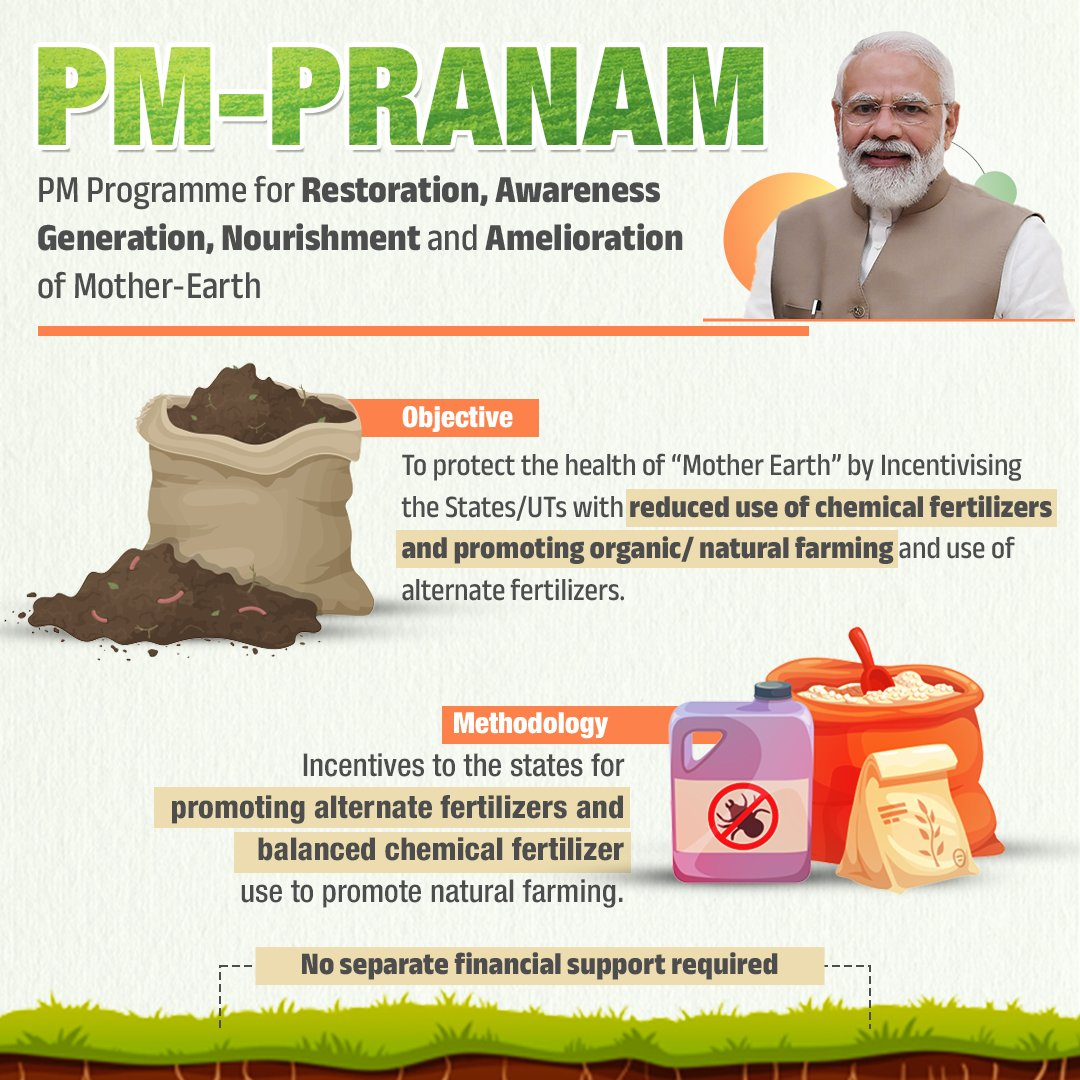PM-PRANAM Scheme | 06 Jun 2025
Why in News?
The PM-PRANAM scheme, aimed at reducing synthetic fertilizer use, has shown initial success with a reduction of 15.14 lakh tonnes of fertilizers in 2023–24, resulting in substantial subsidy savings.
Note: Karnataka alone accounted for 30% of total savings, followed by Maharashtra, West Bengal, and Andhra Pradesh, which together contributed 58% more.
What is the PM-PRANAM Scheme?
- About: PM-PRANAM (Programme for Restoration, Awareness, Nourishment, and Amelioration of Mother Earth) was approved in June, 2023 to reduce chemical fertilizer use by incentivizing states to adopt alternative fertilizers.
- It is operational for a period of 3 years (FY 2023-24 to FY 2025-26).
- Target Savings: The ultimate goal of PM-PRANAM is to achieve a ₹20,000 crore reduction in fertilizer spending, a significant target that reflects the long-term strategy to reduce chemical fertilizer dependency while promoting sustainable agriculture.
- It encourages the balanced use of chemical fertilizers alongside biofertilizers and organic fertilizers through organic and natural farming practices.
- Tracking Mechanism: The Integrated Fertilisers Management System (iFMS) is the platform envisaged to track the use of fertilisers.
How Can the PM-PRANAM Scheme Contribute to Sustainable Agricultural Practices in India?
- Reduction in Chemical Fertilizer Use: PM-PRANAM encourages States to minimize excessive chemical inputs like urea, DAP (Diammonium Phosphate), NPK (Nitrogen, Phosphorus, Potassium), and MOP (Muriate of Potash), thereby reducing environmental risks like soil degradation, water contamination, and biodiversity loss.
- A state's urea consumption reduction will be measured against its three-year average to determine eligibility for subsidy savings and grants.
- Resource Conservation Technologies: The Centre grants 50% of subsidy savings to states, with 70% allocated for assets supporting alternative fertilizer technology and production, and 30% for rewarding farmers, panchayats, and stakeholders involved in fertilizer reduction and awareness.
- Organic and Alternative Farming: The scheme strongly supports the shift towards organic farming and sustainable alternatives, aiming to improve soil health and decrease dependency on synthetic fertilizers.
- Positive Environmental Impact: The scheme is being financed by savings from existing fertilizer subsidies from the Ministry of Chemicals & Fertilizers, with no separate budget allocated for PM-PRANAM.
- It helps mitigate water contamination, soil salinity, and biodiversity loss associated with electricity subsidy to farmers.
UPSC Civil Services Examination, Previous Year Questions (PYQs)
Prelims
Q. With reference to chemical fertilizers in India, consider the following statements: (2020)
- At present, the retail price of chemical fertilizers is market-driven and not administered by the Government.
- Ammonia, which is an input of urea, is produced from natural gas.
- 3.Sulphur, which is a raw material for phosphoric acid fertilizer, is a by-product of oil refineries.
Which of the statements given above is/are correct?
(a) 1 only
(b) 2 and 3 only
(c) 2 only
(d) 1, 2 and 3
Ans: (b)
Q. Consider the following organisms: (2013)
- Agaricus
- Nostoc
- Spirogyra
Which of the above is/are used as biofertilizer/biofertilizers?
(a) 1 and 2
(b) 2 only
(c) 2 and 3
(d) 3 only
Ans: (b)

